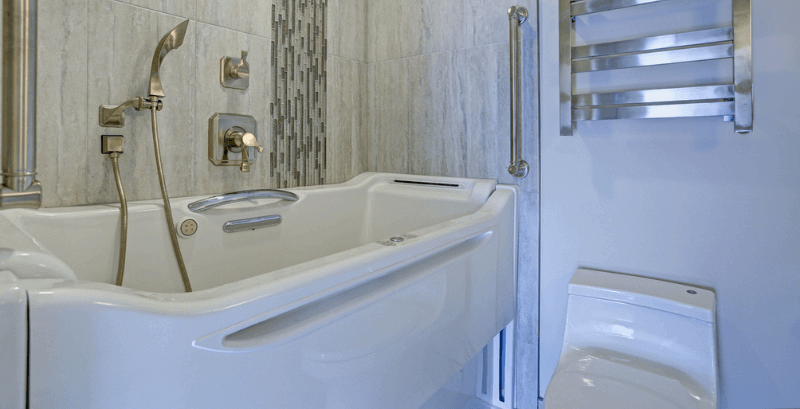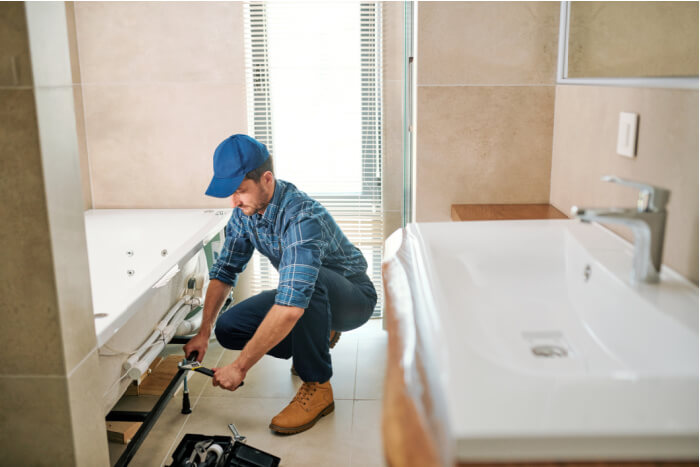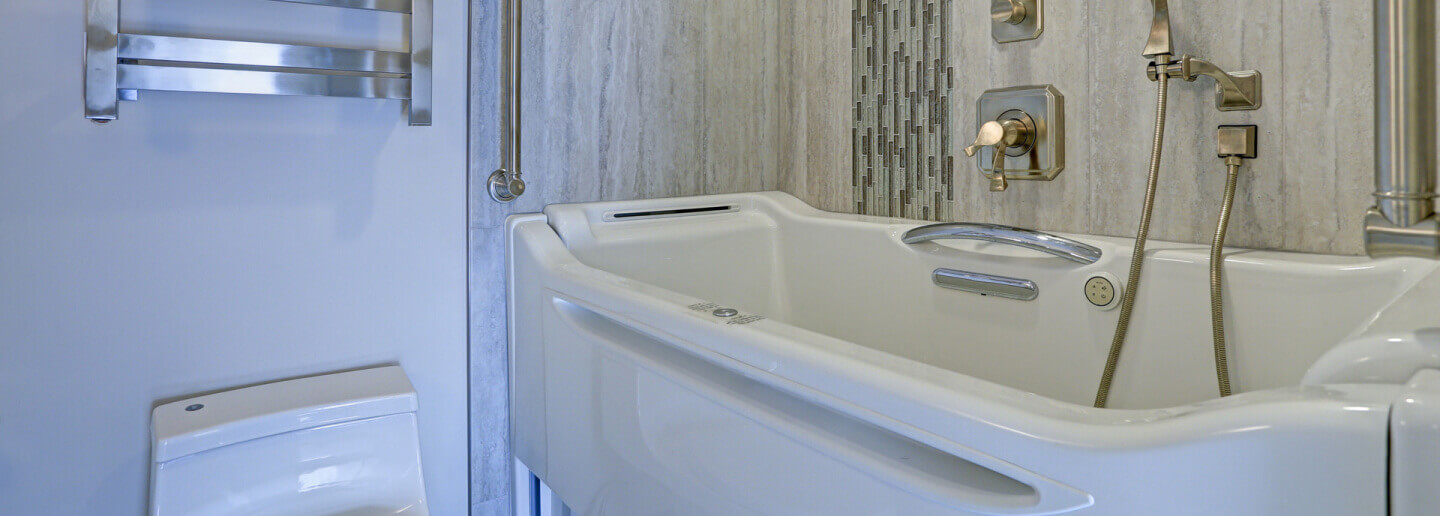Walk-In Tub Installation
Those who want to age in place or have loved ones who cherish their independence often find themselves looking at ways to make homes safer for seniors. These safety elements in the home can take many forms, from railings along hallways to proper nighttime lighting to stair lifts and other mobility devices. Walk-in tubs are getting a great deal of attention by homeowners in 2024 looking to make home accessibility modifications. These are bathtubs that are designed with a leak proof door and a low threshold, making it easy and safe to step inside the tub.
Curious about how a walk-in tub can make your senior family member safer? In this guide we cover tubs for seniors and mobility challenged homeowners. We discuss the cost of walk-in tubs, types available, and how to find a professional in your area that can guide you through installation.
Why are Walk-In Tubs Needed in Homes Today?
Why are walk-in tubs important for seniors and those with mobility challenges? In a typical bathtub, a person must lift their leg more than a foot off the floor to move into the tub. For someone with mobility issues, this can mean loss of balance, trouble with coordination, and potentially a life-threatening fall.
In fact, the CDC reports that three million older adults are treated in emergency rooms each year for falls, and at least 300,000 older people are hospitalized with hip fractures each year. More than 95% of those hip fractures are caused by falling, usually by people falling sideways — the same way most would fall if they tripped over the high side of their bathtub.
Features of Walk-In Tubs
Walk-in tubs are quite different from your typical bathtub. They have a variety of safety features that help lower the risks of injury in the bathroom.
Walk-in tubs are constructed with a door that opens to reveal a very low threshold, thus allowing you to “walk into” the tub instead of lifting your legs to get into it. The door then closes firmly behind the occupant. This creates a leak-proof seal that allows you to fill the tub with water without worry about making a mess on the bathroom floors!
Standard Safety Features
As you search for a new walk-in tub, you will notice that all walk-in tubs come with the same standard safety features. These features are designed to keep you or your loved one as safe as possible while using the tub. Standard walk-in tub safety features that should come with every walk-in tub include:
- Sturdy grab bars
- Inward or outward swinging door
- Low threshold for safe entry
- Raised seat, possibly curved for comfort
- Slip-resistant flooring
- Anti-scald water temperature protection
Optional Features for Comfort
There are features you can add to your walk-in tub to make it as comfortable as possible for your liking. Comfort features for a new walk-in tub to look for include:
- Quick-fill spouts
- Quick-drain (some in 60 seconds or less)
- Detachable spray spout or showerhead
- Aromatherapy and chromotherapy devices
- Hydrotherapy massage jets
- Self-cleaning technology
It is also helpful to know that an alternative to the walk-in tub is the roll-in shower. Designed for wheelchair users, a roll-in shower also has a low threshold and an ADA compliant seat, but allows for a shower rather than a bath when it comes time for bathing.
Types and Costs of Walk-In Tubs
There are several different types of walk-in tubs to choose from. The one you choose depends upon medical conditions, what features you prefer, and even an option to allow for use by a variety of family members.
Today, there are tubs designed for larger individuals, those with chronic muscle aches and pains, those who use wheelchairs and so much more. We encourage you to explore the different types of walk-in tubs and their average prices.
In many cases, homeowners have to pay out of pocket for a walk-in tub. Walk-in tub prices vary depending on types and styles. But there are some other considerations as well, such as how extensive the installation process might be.
We recommend comparing the top walk-in tub brands and their prices to get a sense for the cost of a high-quality, long-lasting tub.
Dimensions of a Walk-In Tub
Choosing the right size walk-in tub is important for your health and needs, as well as ensuring the tub will fit in your bathroom.
Walk-In Tub Length and Width
Most walk-in tubs are designed to fit in the alcove space of a standard bathtub.
A standard bathtub’s dimensions are 30 inches wide by 60 inches long, and most walk-in tubs also have 30″ W x 60″ L dimensions, but the standard width can be up to 32″. To put these dimensions into perspective, most “companion tubs,” which are designed to fit two users at the same time, are 60 inches in length.
Some brands carry smaller walk-in tubs for petite individuals that feature a shorter length – as small as 40 inches in length. Keep in mind that if you plan to recline in the tub, you will need a length of closer to 60 inches.
Walk-In Tub Height
Walk-in tubs are usually taller than standard bathtubs. Because most users sit inside of these tubs, the water depth needs to be about 3 to 4 feet in height to reach the user. Walk-in tubs have a height of 20 to 45 inches tall, though some types do not require as much height.
Water Capacity and Hot Water Requirements
Keep in mind that due to the height, walk-in tubs usually require more water capacity than standard bathtubs. It is important to make sure your home’s water heater can support the water needed during a bath.
The smallest walk-in tubs need 38 to 40 gallons of water per bath, and the largest walk-in tubs can require 100 or more gallons of hot water. To put this into perspective, according to Energy.gov, a typical shower requires 20 gallons of hot water.
Modernize recommends talking to your contractor about the size of your hot water heater, and checking to see if your home may need to upgrade its size to support your new walk-in tub.
Wheelchair Accessible Tub Dimensions
Wheelchair accessible walk-in tubs are not necessarily larger than standard walk-in tubs – they typically have the same standard dimensions. However, wheelchair accessible tubs do require extra clearance space for their outward-swinging door. When planning your walk-in tub installation, be sure there is sufficient clearance near the door to open and close comfortably.
Does Insurance Cover Walk-In Tubs?
Given the cost, you might wonder if insurance will pay for the tub and installation. While some insurance companies might cover a safe-step tub as a preventative care item, which allows a person to be in better health and avoid medical issues and hospitalizations as they age, most insurance companies will not. Though many insurance companies pay for “durable medical equipment” they likely do not include walk-in tubs. The only way to know for sure what your insurance company would cover is to look over your policy very carefully and talk to your insurance representative.
When it comes to Medicare, it is possible that walk-in tubs could be covered. Medicare Advantage, which is run by private insurance companies and regulated by Medicare, offers extra benefits that cover things under the umbrella of “home modification” and “home safety devices.” Be sure to check with your particular Medicare Advantage plan to ensure what is covered and what is not. You can also explore other payment and insurance coverage options available that may cover your tub installation.
Finding the Right Tub Contractor
It is important to find the best contractor to install your walk-in tub, or any other home accessibility improvement that might mean the difference between safety or serious injury for your loved one.
Walk-in tubs are definitely not a do-it-yourself kind of project. It is a project you must entrust to someone who has worked with tub installation before and can handle the plumbing and electrical changes that go along with it, as well as any modifications for special features or size of tubs in the existing space.
Modernize connects you with local contractors who have a wealth of experience in a variety of remodeling and construction projects. Using Modernize, you can be sure to find a professional who has experience with universal design elements, such as safe-step showers and tubs. We will guide you through what questions to ask, what you need to know about the process, and most importantly, let us help you find the contractor who can make it all come together to create an attractive, useful, and safer bathroom.









